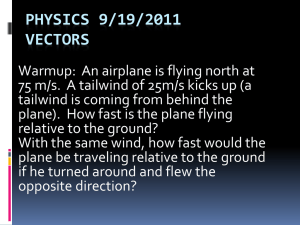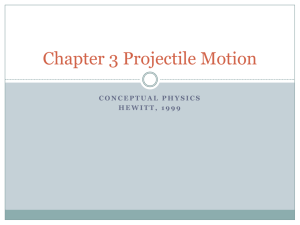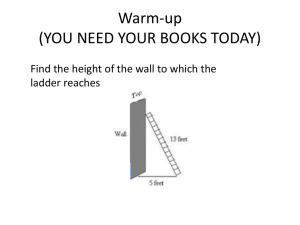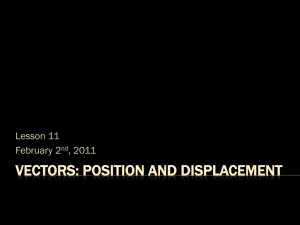VEC-L2 - Killarney School
advertisement
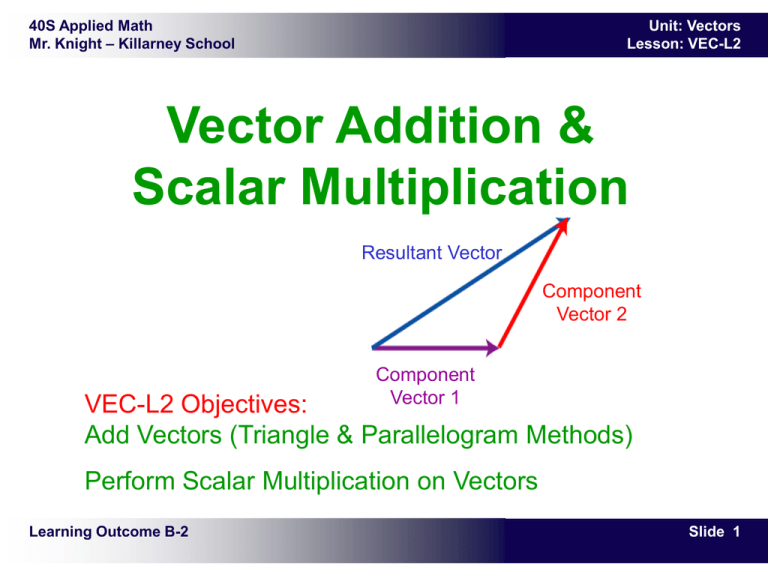
40S Applied Math Mr. Knight – Killarney School Unit: Vectors Lesson: VEC-L2 Vector Addition & Scalar Multiplication Resultant Vector Component Vector 2 Component Vector 1 VEC-L2 Objectives: Add Vectors (Triangle & Parallelogram Methods) Perform Scalar Multiplication on Vectors Learning Outcome B-2 Slide 1 40S Applied Math Mr. Knight – Killarney School Unit: Vectors Lesson: VEC-L2 Whenever two vectors act on an object, the overall effect of the vectors can be found by adding them. In vector addition, we place the tail of the second vector at the head of the first vector. The sum of the vectors, called the resultant vector, is the vector that goes from the tail of the first vector to the head of the second one. Theory – Vector Addition Slide 2 40S Applied Math Mr. Knight – Killarney School Unit: Vectors Lesson: VEC-L2 An athlete is swimming downstream in a river with a current of 0.5 m/s. The swimmer's speed in still water would be 1.2 m/s. What is the swimmer's speed with respect to the shore? When adding vectors, we place the tail of the second vector at the head of the first. The resultant vector represents the velocity of the swimmer as observed by someone on shore. Theory – Addition, Same Direction Slide 3 40S Applied Math Mr. Knight – Killarney School Unit: Vectors Lesson: VEC-L2 The athlete from the previous page is now swimming in the opposite direction against the current. The vectors representing the swimmer and the current are shown below. We again add the vectors by placing the tail of the second vector at the head of the first. The resultant vector represents the velocity of the swimmer as observed by someone on shore. Theory – Addition, Opposite Direction Slide 4 40S Applied Math Mr. Knight – Killarney School Unit: Vectors Lesson: VEC-L2 When we multiply a vector by a scalar, the magnitude of the vector is multiplied by the scalar and the direction does not change. Mike's turtle walks 12 feet east per minute towards the river. Draw vectors that represent the turtle's displacement in one minute and in three minutes. In one minute: In three minutes: Theory – Scalar Multiplication Slide 5 40S Applied Math Mr. Knight – Killarney School Unit: Vectors Lesson: VEC-L2 Vectors aren’t always collinear. When we solve problems that involve vectors, we usually draw a sketch of the situation. This sketch will always have at least three vectors: •two or more component vectors, which are the vectors that make up the input to the problem and are added together to get the answer. The vectors are component vectors. •a resultant vector, which is the result of adding the components. This is usually the answer to the vector problem. Triangle Law of Addition: We again add the vectors by placing the tail of the second vector at the head of the first. The resultant vector represents the velocity of the swimmer as observed by someone on shore. Theory – Triangle Law of Addition Slide 6 40S Applied Math Mr. Knight – Killarney School Unit: Vectors Lesson: VEC-L2 Use the vectors shown to the following calculations. Just sketch rough answers; you do not need to draw scale diagrams. Examples for Practice Slide 7 40S Applied Math Mr. Knight – Killarney School Unit: Vectors Lesson: VEC-L2 A swimmer heads north across the river from one shore to the other at 1.2 m/s. The river current is 0.5 m/s east. Determine the magnitude and direction of the resultant velocity of the swimmer. The vectors S and R represent the velocities of the swimmer in still water and the river respectively. Theory – Triangle Addition Example Slide 8 40S Applied Math Mr. Knight – Killarney School Unit: Vectors Lesson: VEC-L2 To determine the magnitude and direction of R , we need to draw a scale diagram of the triangle using pencil, paper, ruler, and protractor. A suitable scale might be: 1 cm = 0.1 m/sec. We now measure the length of the resultant using the ruler, and the direction of the resultant using a protractor. The resultant vector has a length of 13 cm, which represents a magnitude of 1.3 m/sec, and a direction of N23°E. Theory – Triangle Addition Example Slide 9 40S Applied Math Mr. Knight – Killarney School Unit: Vectors Lesson: VEC-L2 A plane flies 240 km south, then 140 km west. The pilot wants to return directly to the starting point. How far and in what direction must he fly? Examples for Practice Slide 10 40S Applied Math Mr. Knight – Killarney School Unit: Vectors Lesson: VEC-L2 A plane flies 240 km south, then 140 km west. The pilot wants to return directly to the starting point. How far and in what direction must he fly? Examples for Practice Slide 11 40S Applied Math Mr. Knight – Killarney School Unit: Vectors Lesson: VEC-L2 An ultralight plane is headed N30ºW at 40 km/h. A 12 km/h wind is blowing in the direction E20ºS. What is the resultant velocity of the ultralight plane with respect to the ground? Examples for Practice Slide 12 40S Applied Math Mr. Knight – Killarney School Unit: Vectors Lesson: VEC-L2 An ultralight plane is headed N30ºW at 40 km/h. A 12 km/h wind is blowing in the direction E20ºS. What is the resultant velocity of the ultralight plane with respect to the ground? Examples for Practice Slide 13 40S Applied Math Mr. Knight – Killarney School Unit: Vectors Lesson: VEC-L2 In the previous examples, we used the triangle method of vector addition, where we attach the tail of the second vector to the head of the first, and then draw the resultant from the tail of the first to the head of the second to complete a triangle. We may also use the parallelogram method illustrated below. Component vectors a & b represent two forces acting on an object. In this case, we arrange the component vectors tail to tail, and complete a parallelogram as shown by the red arrows. The resultant is the diagonal of the parallelogram. Theory – Parallelogram Method Slide 14 40S Applied Math Mr. Knight – Killarney School Unit: Vectors Lesson: VEC-L2 Kathy and Brenda pull a wagon by exerting forces of 36 N and 42 N respectively using ropes attached to the front of the wagon. The angle between the ropes is 30º. What is the resultant force on the wagon? Set your scale, then solve using the parallelogram method. Examples for Practice Slide 15 40S Applied Math Mr. Knight – Killarney School Unit: Vectors Lesson: VEC-L2 Kathy and Brenda pull a wagon by exerting forces of 36 N and 42 N respectively using ropes attached to the front of the wagon. The angle between the ropes is 30º. What is the resultant force on the wagon? Examples for Practice Slide 16


